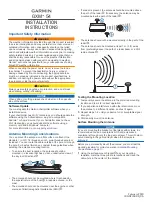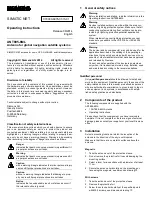
19
Troubleshooting Check List for Initial Installation
If the signal is not found, be sure the receiver and antenna user manual have been followed closely, please check
the following:
• Make sure all cable connections are correct and each connection is properly connected.
• Inspect the inside of each cable connector for dirt or possible connector to case/shield short.
• Verify the Azimuth, Elevation and Tilt angles for your location by ZIP code.
• Make sure the Tilt and Elevation pointers are aligned correctly to the scales. Do not use washer or bolt as
reference.
• Make sure the Tilt adjustment is not changed from the recommended setting for the antenna location.
• Remove existing TV-specific components, such as TV splitter, etc; reduce the installation to the basic connec-
tions mentioned in this guide. Such components may not work with the satellite signal and they may be in the
wall where you can’t see them. When in doubt. Run a cable directly to your receiver.
• Make sure there are no obstructions (trees, buildings, windows, corner or overhang of your roof, your body or
hands) – the signal does not pass leaves, branches, glass, etc.
• RG 6 cable with solid copper center conductor is highly recommended because it has much lower DC voltage
drop compared to RG 6 cable with a copper-coated, steel center conductor.
• Standard RG 59 cable causes too much DC drop and signal drop; it cannot be used to pass the satellite signal.
RG 6 coaxial cable with a screening attention of 110dB should be used.
• Some after-market, off-the-shelf add-on components may not be as advertised. They might not work or could
cause additional DC drops and signal amplitude attenuation. Remove such components. Go back to the basic
connections mentioned in this manual and recheck.
• Make sure the satellite cable is connected to the “Sat In” jack, not the “Antenna In” jack, The “Antenna In” jack
at the back of the receiver is for off-air antenna input or cable TV input.
• If all are done correctly but the signal is still not found. Change the Elevation adjustment of the antenna slightly
(±2°, then ±4°from the called-for setting) and repeat the procedure.
• Make sure your receiver is turned to a free TV broadcasting station.
Temporary loss of Signal / Rain Fade
• The satellite signal may be lost temporarily due to unusually heavy rainfall. An optimally aligned antenna, along
with the shortest possible cable, minimizes the chances of “rain fade.”
• Make sure the antenna is mounted securely to prevent it from being blown out of alignment in a heavy wind.
• Heavy snow accumulation on the antenna may reduce the satellite signal strength, snow should be swept away
as soon as possible.
• Tree foliage growth into antenna’s line-of-sight to the satellite may result in gradual loss of picture.
Summary of Contents for SFA60
Page 22: ...20...




































